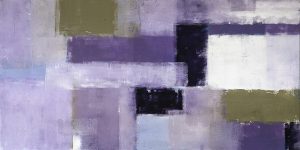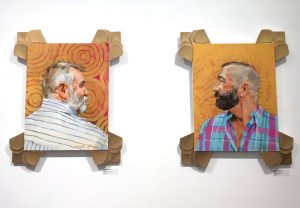As someone who is not a frequent advocate of abstract art, I, surprisingly, thoroughly enjoyed Leslie Johnston’s work. She is first and foremost an environmental scientist by profession, so it comes as no surprise that her art reflects her passion for preserving natural habitats and species. Her current exhibit at the Touchstone Gallery, a small space that exhibits the work of its 45 member artists, does exactly that. (https://symboliamag.com) The installation of a multitude of monochrome ceramic tiles that make up “Before They Are Gone” is meant to profoundly, even ominously, represent the decline of the African elephant population due to poaching and hunting.
The first thing one sees as they approach the exhibit, located in one of the corners of the gallery, is the title of the piece emblazoned upon the wall. Underneath it rests a large-scale ceramic circle with a black center and lines, representing a target. On the wall opposite that, there are three circular ceramic pieces, meant to represent ivory, the main thing elephants are killed for. As you turn the corner, you suddenly find yourself in a small almost room, surrounded by three walls, upon which are placed a huge number of black, gray, and cream ceramic tiles. It comes as a shock to learn that this number is 2500, and the shock is all the more powerful when one realizes that this depicts the average number of elephants killed per month in Africa in recent years.
The sheer magnitude of the exhibit is arresting, and there are so many tiles of different textures that one can easily get caught up in trying to examine each of them before stepping back to get the full experience again. The effort that was put into the installation is very obvious, so it comes as no surprise that it took over a year to finish, according to the gallery director Ksenia Grishkova, and 80 hours to install. Like the majestic elephants they represent, each tile is unique and enthralling in its own right. The exhibit effectively gets the viewer to take a moment to appreciate the immensity of this problem. Grishkova stated that spectators are forced to experience this because of the shape of the room, and Johnston wanted people to “stand in a circle and feel uneasy.”
Despite my initial reservations upon finding out that this exhibit was abstract art, I was impressed by how clearly the message of the piece came across, without losing the aim of an art piece, which is to make the viewer think.





